It’s a dangerous business, Frodo, going out your door. You step onto the road, and if you don’t keep your feet, there’s no knowing where you might be swept off to.
Bilbo Baggins, The Lord of the Rings
The inestimable Bilbo Baggins knew a thing or two about stepping onto the road.
Despite protestations to the contrary, he decided as a middle-aged hobbit to take off with a bunch of dwarves he never met and a wizard he hadn’t seen since childhood. Along the way, he tricked a dragon, out-riddled a creature, confounded an Eleven king (not easily accomplished), hobnobbed with a shape-shifting man/bear and came home again wealthier than he ever imagined with a strange gold ring that made him disappear. Not to be outdone, on his “eleventy first” birthday, he greeted the road once again, leaving his cozy home of Bag End (and that ring) and making his way from the hamlet of Hobbiton to Rivendell, the last homely house of the Elves. And finally, at 131, he sailed across the Great Sea to the Undying Lands – a high Elven honor.
Whew! What an adventurer! I make no claim to such rolling stone status myself. But I did have the distinct pleasure recently of traveling the English countryside in the footsteps the man who created Bilbo and indeed Middle-earth – the inestimable JRR Tolkien. This deeply meaningful experience — a bit of a grail, if I’m to be honest with you — came during an 18-day journey that included Cornwall, Glastonbury, Oxford (of course) and, too briefly, Wales. My little Toyota Yaris, Aine (pronounced Ahn-ya), and I traveled more than 900 miles together and I have much to share, so I’m going to get right to it.
Starters
Mine was bound to be a road trip from the start – too many far-flung places, too short a time. So instead of paying usurious summer car rental fees I decided to take the car ferry from Ireland to Great Britain. (This may not be an option for any American readers of my blog traveling from the Republic of Ireland, as rental car companies are very clear that you can’t take the car out of the country – not even to Northern Ireland.) Ferries leave the Republic from Dublin, to Holyhead in northern Wales; and from Rosslare Harbor at the southeastern tip of Ireland, to Fishguard in southern Wales. This is the one I took. The cost is not cheap – I paid €426 roundtrip – but still less than a rental (which started at about €600 and went up from there) and I had my own car so I could take all sorts of stuff without trying to cram what I wanted to bring into one suitcase.
Because I was taking the ferry, I found the excuse to spend two days beforehand in Wexford. This delightful small seaside city of 21,000 should absolutely be on your Ireland to-see list. It just goes and goes and goes, one pedestrianized street after another filled with small shops, cafes and restaurants. And for a charity/thrift shop nut like me, it was heaven. I think I visited at least 8 and I’m sure there were more. (Score: a Fatface shirt for €6!)
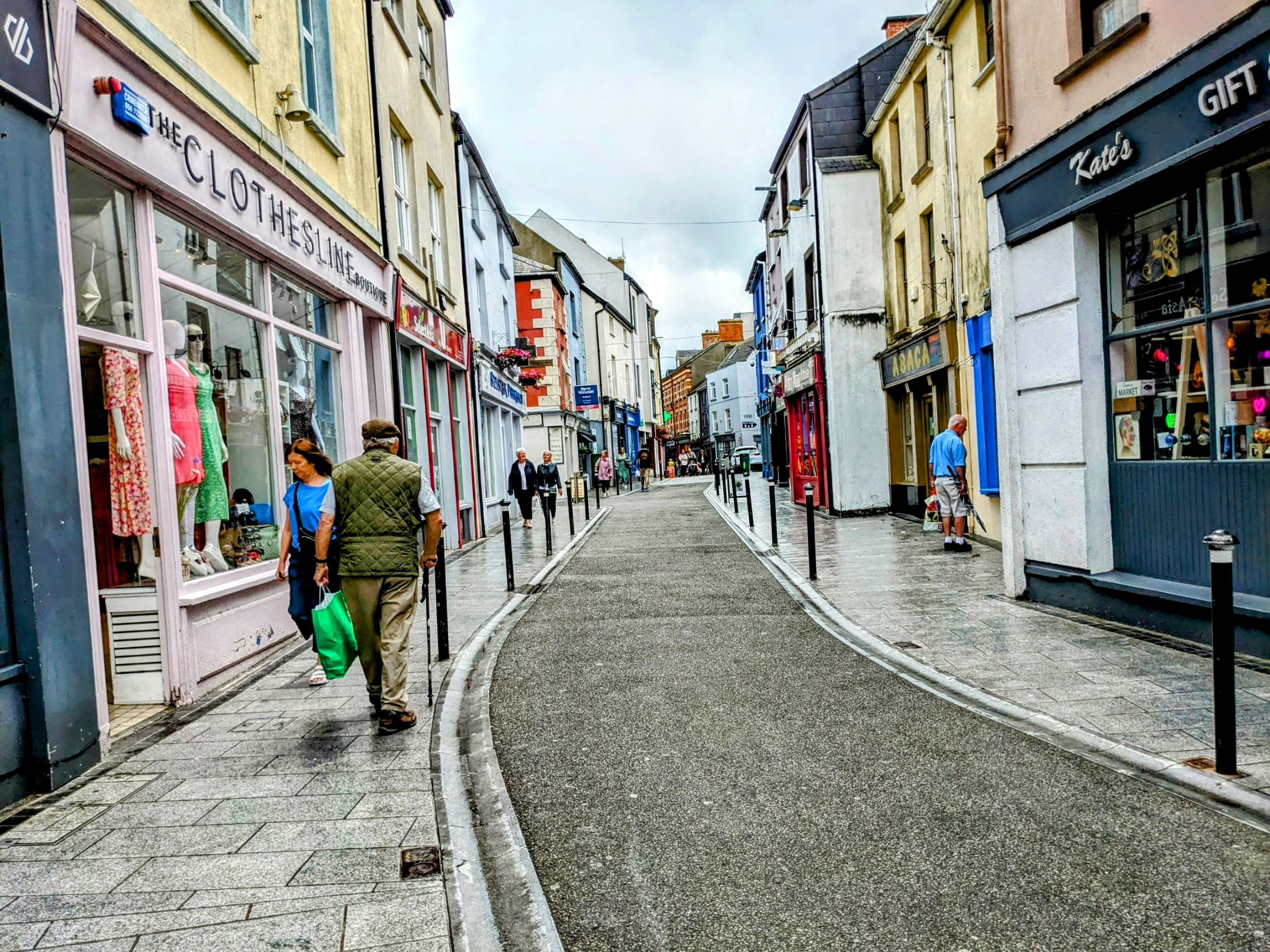
Cornwall
Okay, okay, maybe the vision of a windswept Ross Poldark galloping on his horse along the rugged Cornwall coastline might have had something to do with my desire to visit there. And Cornwall did not disappoint, quite worth the exceedingly long journey to reach this remote part of southern England. I drove from Fishguard to Bristol, where I hooked up with my daughter Bridget and son-in-law Tom, who flew in from Edinburgh via Kigali, Rwanda. From there, we drove to very nearly the end of Cornwall, to the small village of Marazion on the southwest coast where we settled into our lovely cottage by the sea.
Marazion has one major claim to fame, and well worth the visit if you’re staying elsewhere in western Cornwall. St. Michael’s Mount is 12th century monastery-cum-private castle, an enormous Medieval structure on a small island that needs to be seen to be believed. A magnificent 19th century terraced garden abuzz with bees leads up to the castle walls. The castle itself has been in the same family since the 16th century, so you can just imagine the personal imprint of generations untold.
THE FINE PRINT: The island is accessible by foot at low tide. Boats can take you to and from the island if you’re not lucky enough to walk over, for £2.80 one way. A castle and garden combination ticket costs £26. Pricey but worth it.


The view of the castle from the gardens…and a view of the gardens from the castle.
And on your way home, stop by Philps Bakery in the Village and pick up a Cornish pasty – an oversized meat pastry with a thick crust that miners would take down to the tin mines for a compact but substantial meal.
Speaking of tin, Cornwall has been recognized for its tin mining since the Bronze Age and continuing into the 20th century, with the last mine closing in 1998. Not to belabour the point, but any Poldark aficionado worth her salt (not sure the series was a big hit with men…) will remember his often-troubled mine.
Tin mining reached its zenith in the 19th century, and we happened upon one of the most famous of these mines very near the farthest reaches of the county. Botallack Mine, now a UNESCO World Heritage Site, was in its day celebrated not only for its technological advances, but as a tourist destination – visitors could travel down a shaft below ground to see mining operations in action. Today, the remains of its buildings are spread out over a sprawling area of walking trails and tufted grass ending at tall sea cliffs. Stunning. I would definitely recommend a visit, and plan to spend some time.
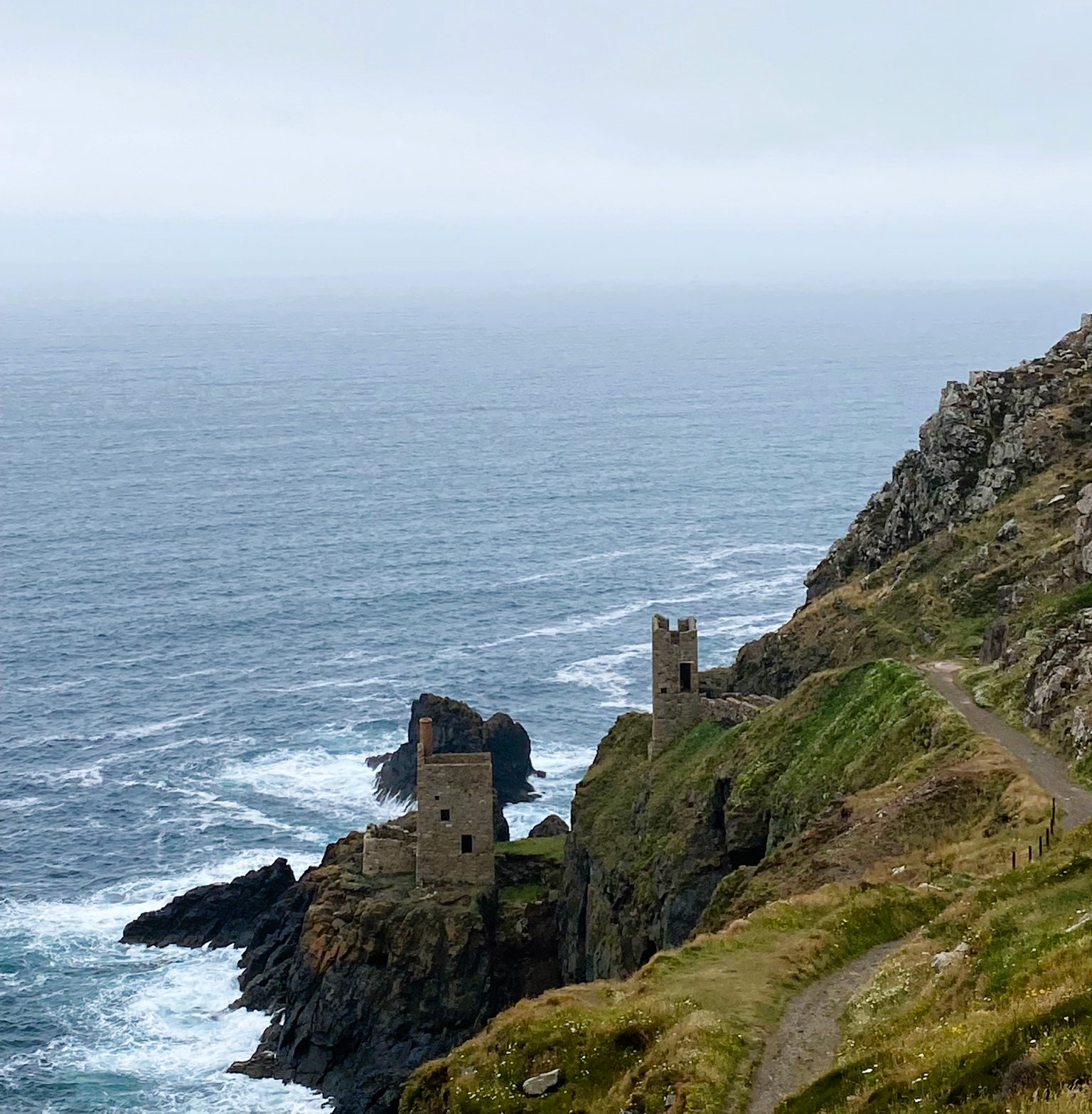
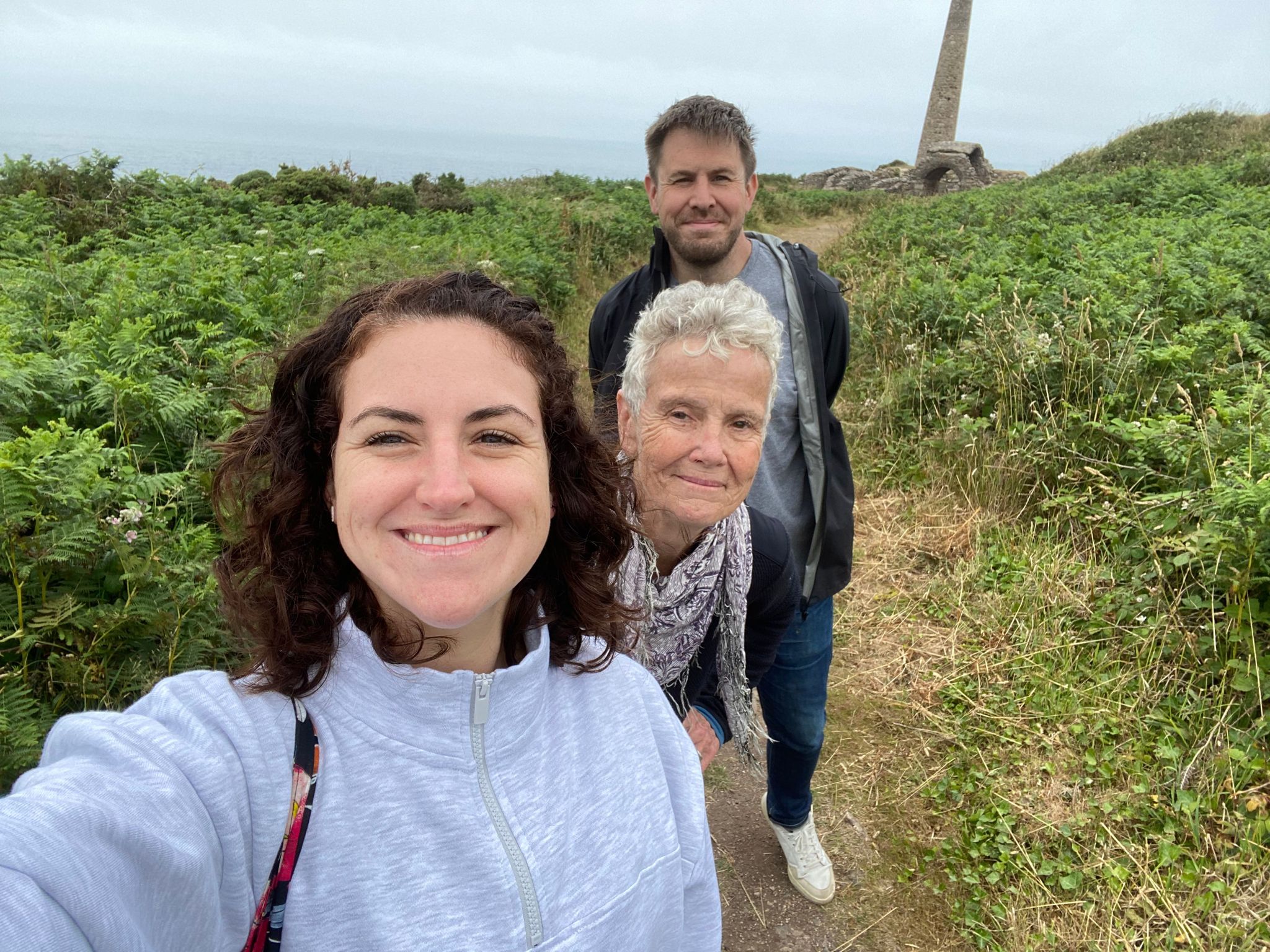
Botallack Mine buildings on the rugged shore. Miners were mining the tin in caves underneath the cliffs. Bridget, Tom and I at the mine.
I think it’s pretty much incumbent upon anyone visiting Cornwall to spend a day at the Eden Project. Built on the site of an old clay mine, it is a complex of massive biomes housing the world’s largest indoor rainforest as well as a Mediterranean environment. Trees grow to the limits of the biomes, paths and wooden bridges take you past fragrant exotic flowers that mesmerize, shrubs and plants from far-flung reaches of the world grow for you to enjoy. And sustainability, as you might imagine, is paramount. My personal favorite? I happened upon a pachouli bush – unremarkable until I rubbed my finger along a leaf and took in the fragrance. My hippie 20-year-old self was very happy.
THE FINE PRINT: We visited the Eden Project in late June, on a weekday before the end of the British school year, and it was still chock-a-block with folks. Parking lots are numerous and color-coded, so take note of where you park. We probably walked 15 minutes to the visitor’s center. But other-abled people are well accommodated there, a friend with limited mobility told me of her recent visit. Entry is actually an annual membership, £33 per person, sometimes more. But while that seems steep, given the scope of what this nonprofit does, it is not unreasonable.

Glastonbury
I bid goodbye to Bridget and Tom, who headed over to Belgium for a music festival (her remark at its conclusion: “Rock is not dead!”), and I travelled to Glastonbury – a place I have always longed to visit.
Myth and magic intertwine with the Jesus story and the Arthur story here, drawing a wide swath of humanity to its borders. Glastonbury is dominated by the Glastonbury Tor, a 518-foot tor, or hill. For many thousands of years until well into the late Middle Ages, the tor was surrounded by a marshy lake. It is here in legend that one accessed the island of Avalon – a magical “Land of Women” governed by 9 sisters and known for its beauty and prosperity. (For a deep dive into Avalon, I highly recommend “The Mists of Avalon” by Marion Zimmer Bradley.) It is in Avalon, according to Geoffrey of Monmouth, that Arthur’s sword Excalibur was forged and where Arthur was taken to recover after he was wounded in battle.
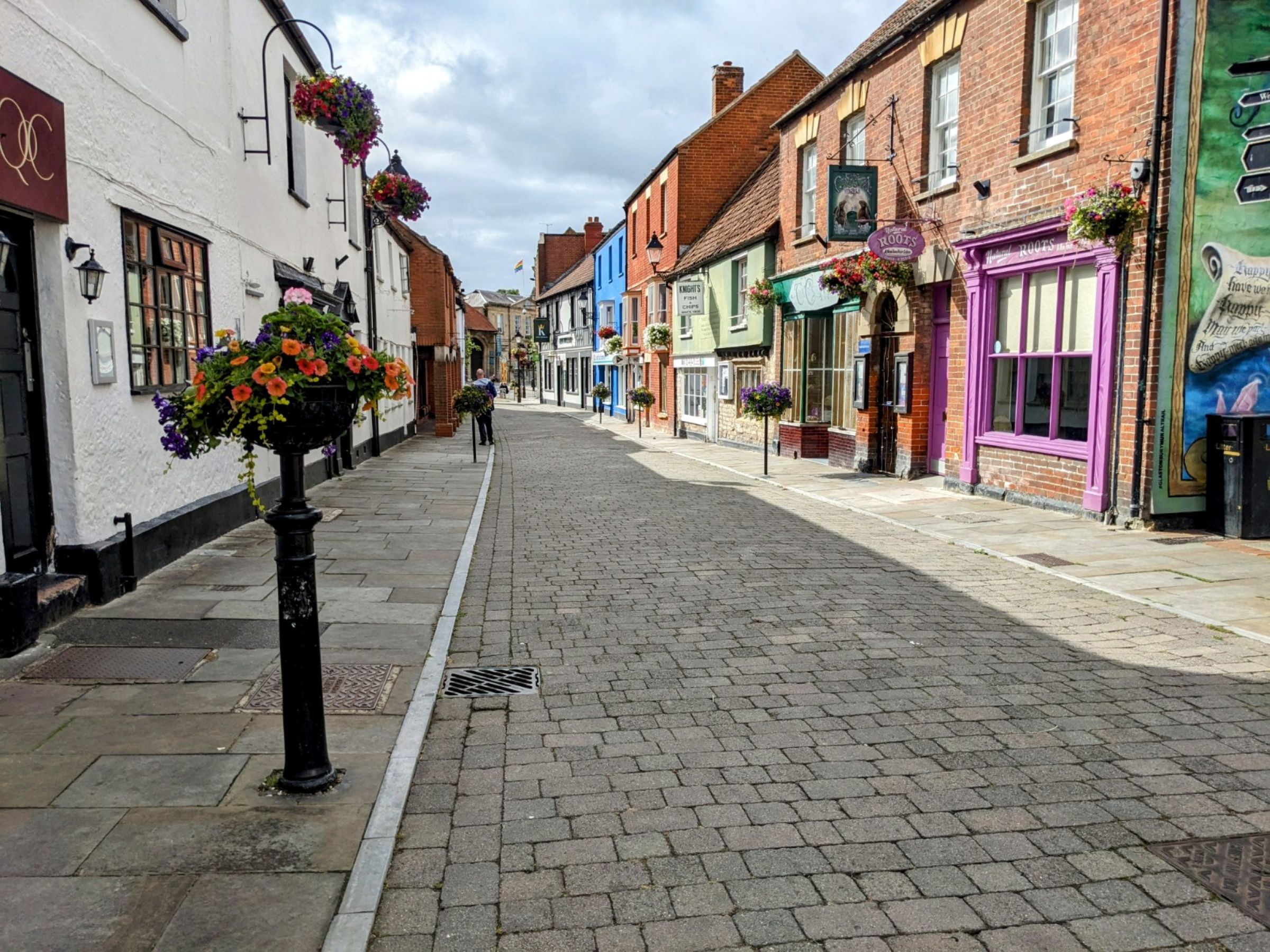
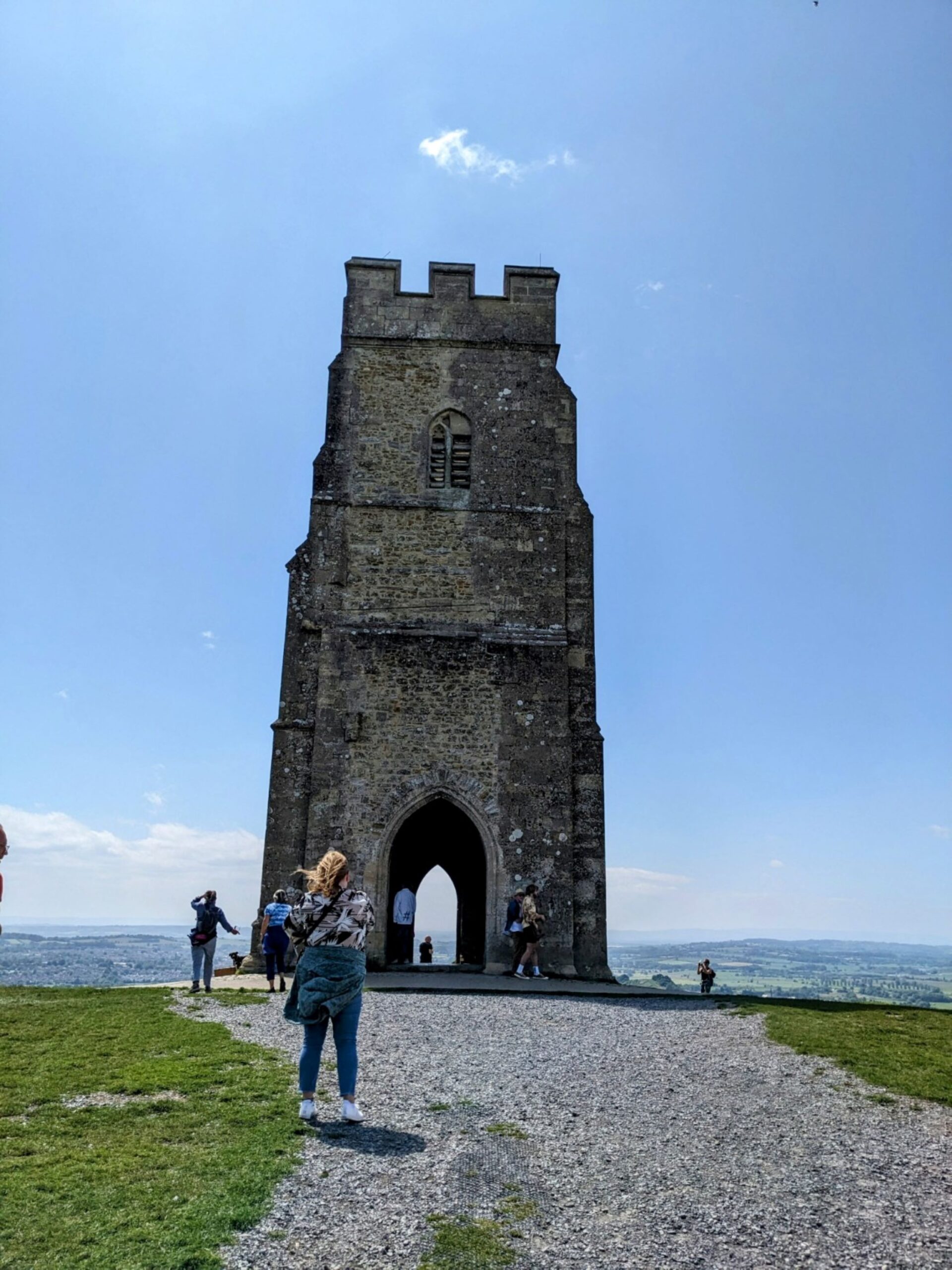
One of many quaint streets in Glastonbury. The Glastonbury Tor, with the remains of a church at its summit and commanding views all around.
The Jesus story also, literally, takes root in Glastonbury as well. Medieval authors believed that Joseph of Arimathea traveled to Glastonbury with the Holy Grail (the chalice used at the last supper), perhaps with Jesus himself. One story has Joseph thrusting his staff into the ground, where by morning a thorn tree grew. Another author said Joseph buried the grail at the base of the Tor, from which subsequently flowed the Chalice Well. He is also alleged to have established the first monastery at Glastonbury and is said to be buried there.
So much spirituality, so much magic in one place! The Tor, owned and maintained by the National Trust, is so worth visiting – although it is a steep journey up many, many steps to get there and the wind at the summit is unrelenting. Close your eyes and imagine a different time, a different space, and be transported. Before or after you make the trek, be sure to visit the Chalice Well and Gardens at its base. Not only is it connected to the grail, in the Avalon mythology, the well was a passage to the underground. THE FINE PRINT: Entry fee is £5 for adults, and its open every day of the year from 10am.
I highly recommend a visit to Glastonbury Abbey, as well. The sheer scope of this complex is mind boggling. While today you see its ruins, what remains and what you can see through your mind’s eye that remains is remarkable. The earliest historical evidence of a monastery dates to the 7th century. Second in size and stature only to Westminster Abbey, it just grew and grew and grew, was rebuilt after a fire in 1184 (!), and by the 16th century its wealth and power peaked. As I stood on the steps of the Lady Chapel, built on one far end of the Abbey, and saw the remains of the central spire perhaps 200 or more feet distant, I was in awe at the scope of what this building must have looked like in its heyday. On the extensive grounds was also a cloister, a chapterhouse and dormitory, the abbot’s hall and the abbot’s kitchen – which remains largely intact. Arthur and Guinevere are alleged to be buried here, moved from the grounds to an abbey crypt after the abbot is said to have had a dream of where they were initially interred. Apparently, too, that thorn tree is still alive and thriving on the grounds.
THE FINE PRINT: Tickets are £11 for adults online, £12 at the Abbey, and two children are free with a paying adult. The Abbey is opened 10am-6pm, 7 days a week, year round. I would recommend taking a tour with a guide. Much the best way of envisioning the place.
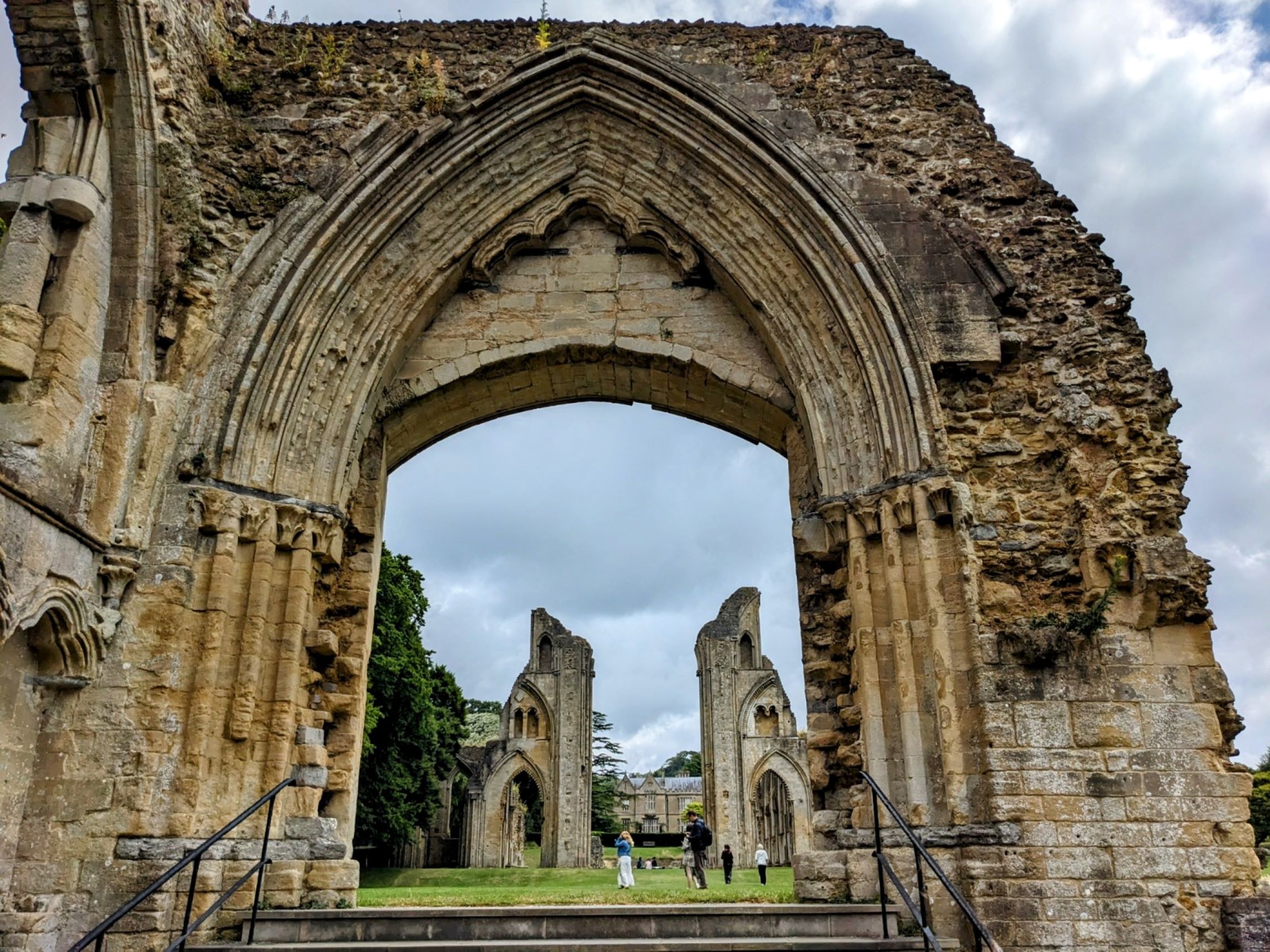
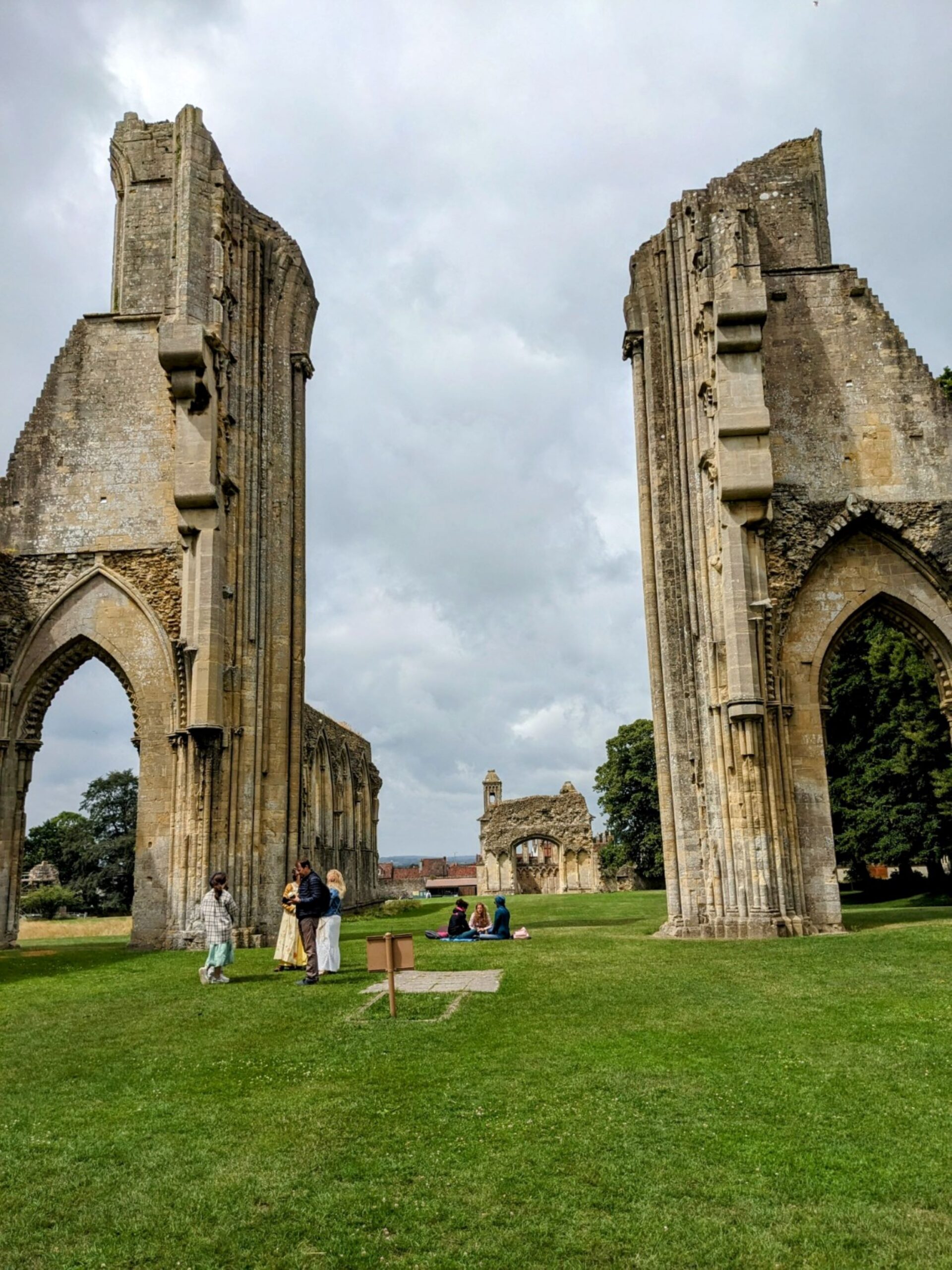
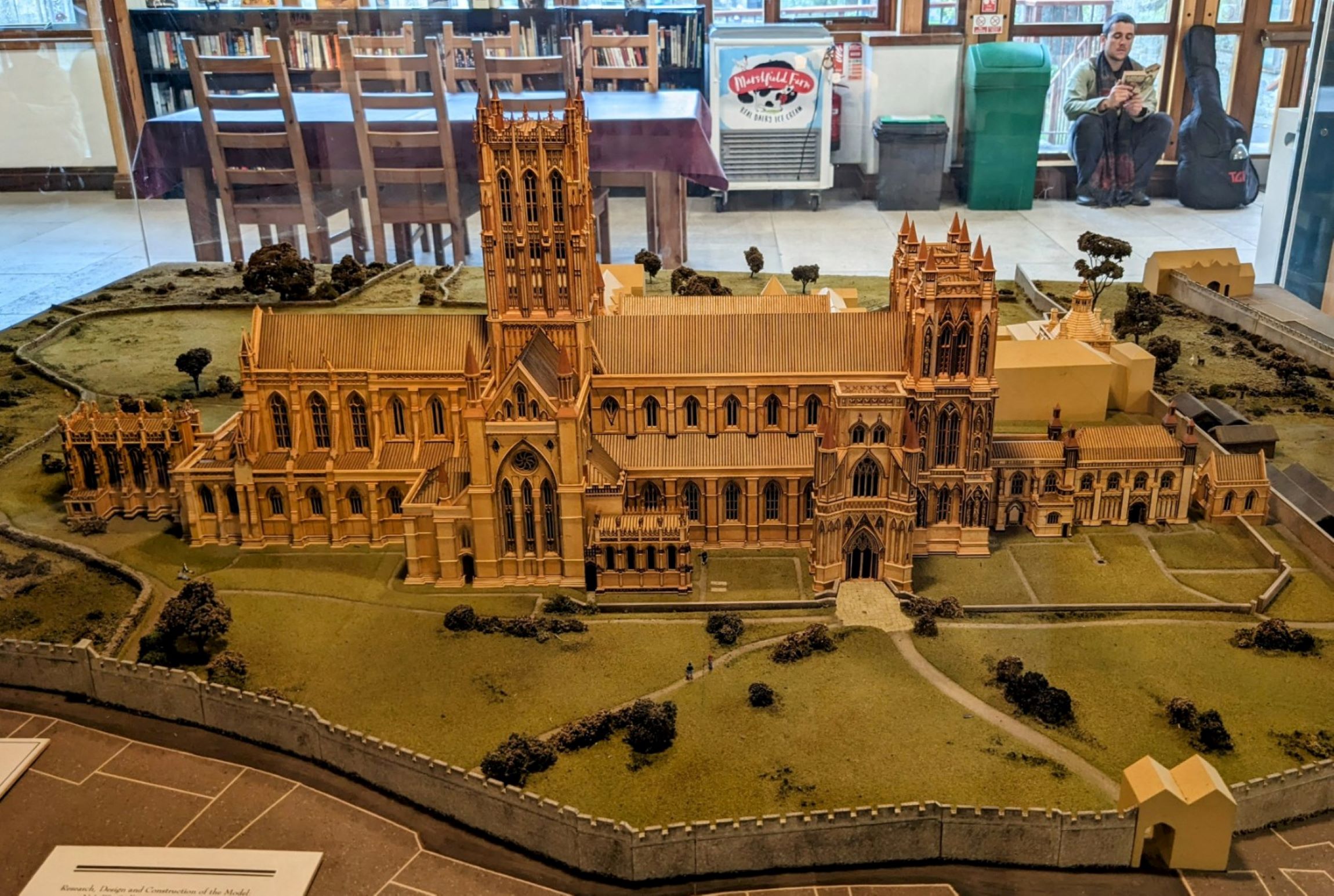
One final note before I leave Glastonbury. No doubt because of its deep spiritual roots, the town itself is home to many folks who find they can be truly themselves there. Young, middle-aged, elder men and women with flowing long hair, clothed in cottons and black garb and billowy skirts and gauze tops are everywhere in profusion. Shops sell crystals and incense and books on mysticism and smudge sticks and billowy skirts. I felt completely at home.
Stonehenge
Just a quick note here about Stonehenge, which I visited on my way to Oxford. I was so near, I really felt it incumbent on me to see this ancient marvel. As most of you likely know, Stonehenge is comprised of two rings of standing stones and lintels aligned toward the summer solstice sunrise. Dating from the Bronze Age, at least 3100 BC, it is UNESCO World Heritage Site and owned by the Crown (meaning King Charles, I presume). It was probably a burial site from its beginnings, and indeed many remains have been excavated there, although it likely also served as a site for rituals of various sorts.
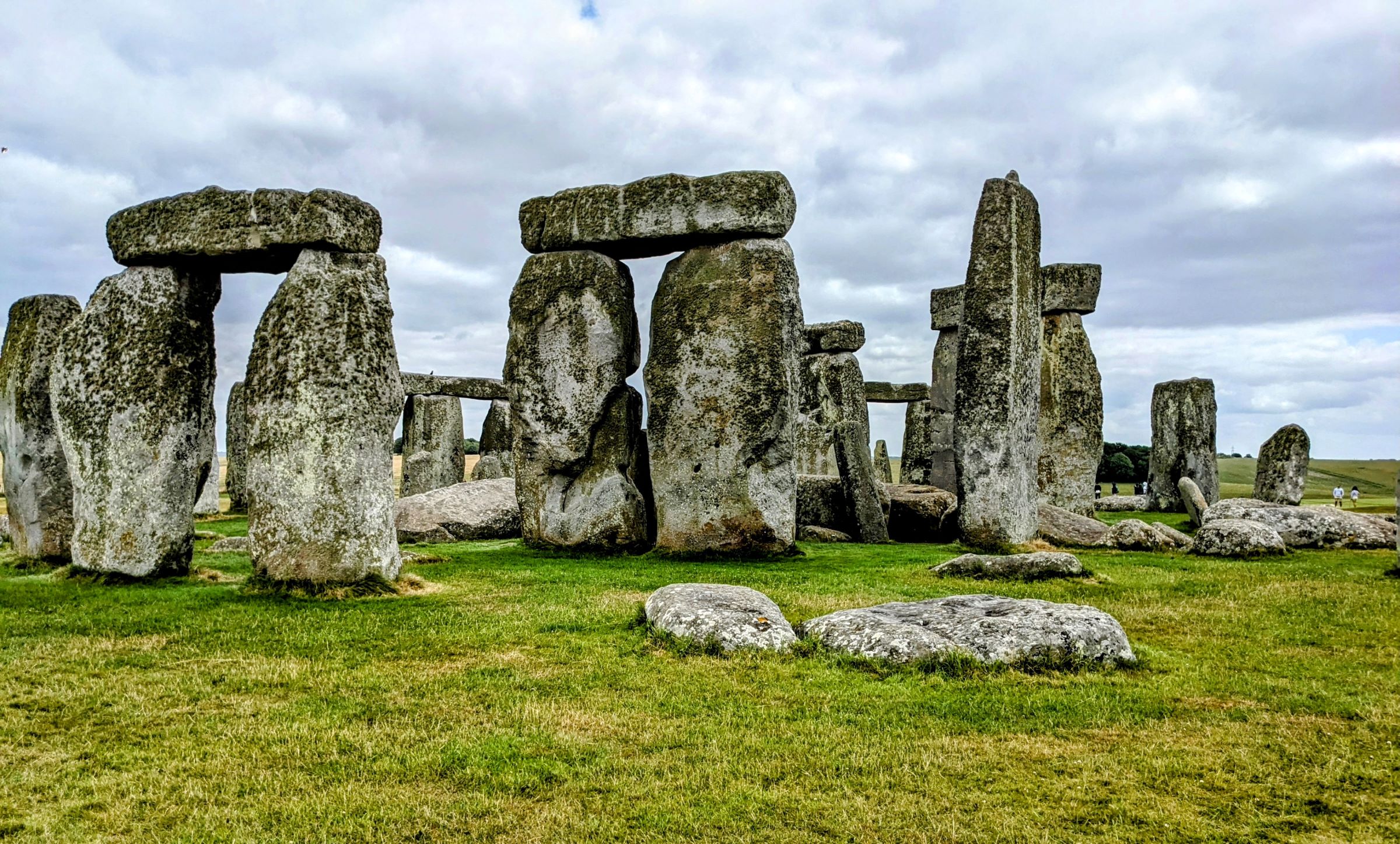
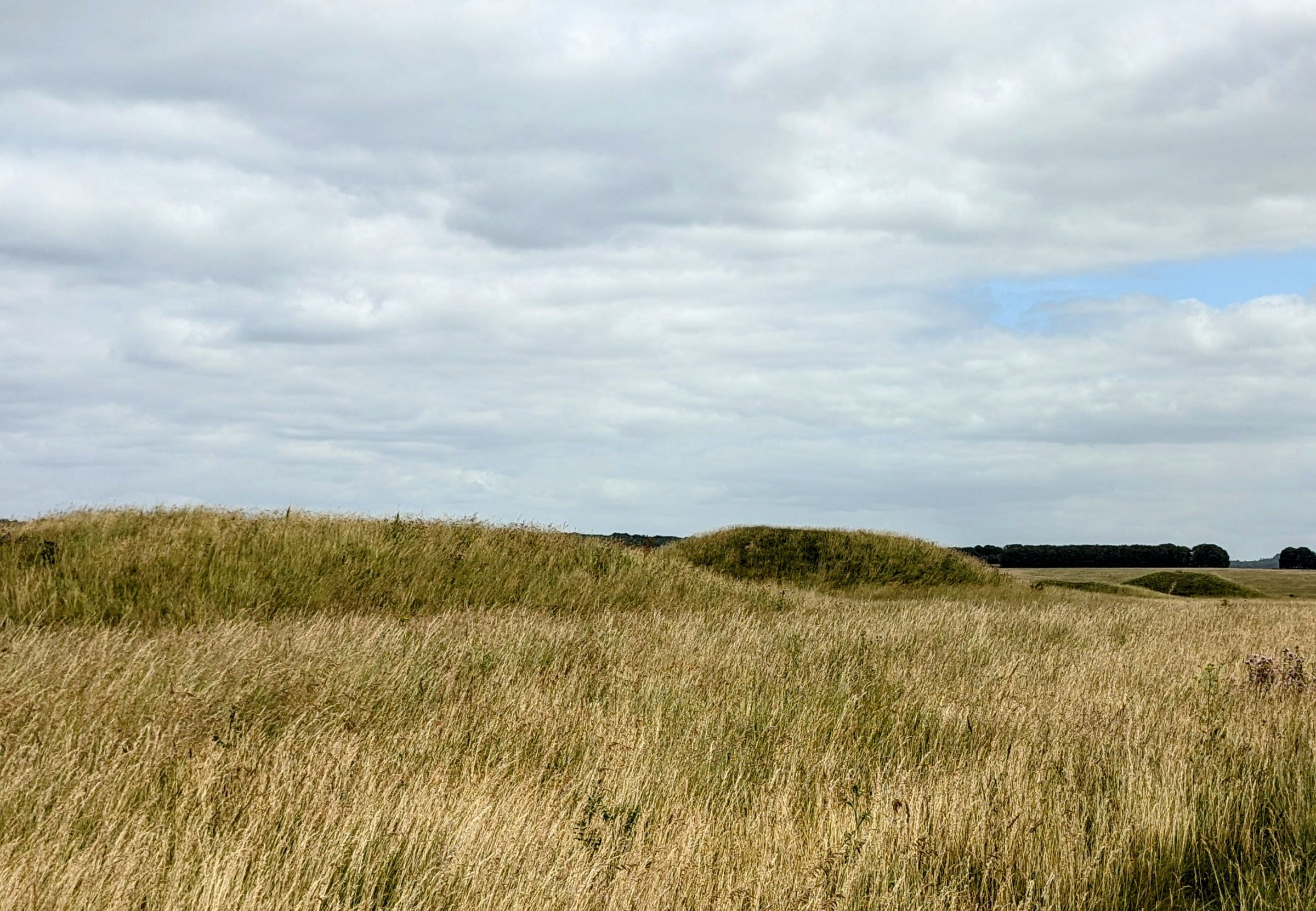
I took the photo of Stonehenge on the left by zooming my lens away from the hordes of photo- and selfie- taking people who were there. Perhaps I should have also taken a crowd shot so that you could picture the entire scene. Alas. On the right are the barrows in the fields. If you look carefully, you can see four mounds.
Let me first state that I am not unhappy I went. Having said that, the monument is not accessible, and is cordoned off some distance away. I totally understand the reason for that, especially given the fact that the place was chock full of people, many of whom seemed to be there for the obligatory selfie and not much more. But I guess I just didn’t feel the ancient pull I was hoping to experience and that was everywhere in evidence in Glastonbury. My suggestion is that you walk to the Stonehenge site via the nearby fields either one or both ways from the visitor’s center, although a bus will take you there. Take the farthest path out and you will see five ancient barrows (burial mounds) in a row. I felt more of a tug there than I did at Stonehenge, truth be told.
THE FINE PRINT: The cost of admission is £23-£29 online, depending on the day of the week and time of the year. The quietest time is before 11am and after 2pm.
Oxford
If Glastonbury was on the bucket list, Oxford as I said earlier was my own personal grail. I have long been a devoted reader of fantasy literature, you see, and Oxford holds a very special place in my heart for this reason. Here once strode CS Lewis and, still today, Philip Pullman, authors of two of my favorite series, ‘The Chronicles of Narnia’ and ‘His Dark Materials.’ (Though truth be told the Christian Lewis and the atheist Pullman both swerved into proselytizing too much for my tastes at the end.) Lewis Carroll wrote the Alice in Wonderland books when he was a lecturer here.
But really, in my lifetime of reading fantasy, no one holds a candle to JRR Tolkien. I first read ‘The Lord of the Rings’ when I was 19 and since then, I’ve read the trilogy (as it has come to be called, as it is three books in one) every few years, probably 23-25 times in all. Tolkien, like his good friend CS Lewis, was a don at the University of Oxford, and a renowned expert of Old and Middle English. But in his private time, he was creating an entire world with its own origin myths, its own beings with their own unique languages, a rich and long history with its good and its evil. The time on Middle-earth of ‘The Hobbit’ and ‘The Lord of the Rings’ is but a small, albeit momentous, moment in the long thread of time that Tolkien created. I am simply in awe of him.
So when The Oxford Centre for Fantasy — an organization dedicated to promoting both Tolkien and fantasy writing — offered a weeklong workshop, how could I resist?
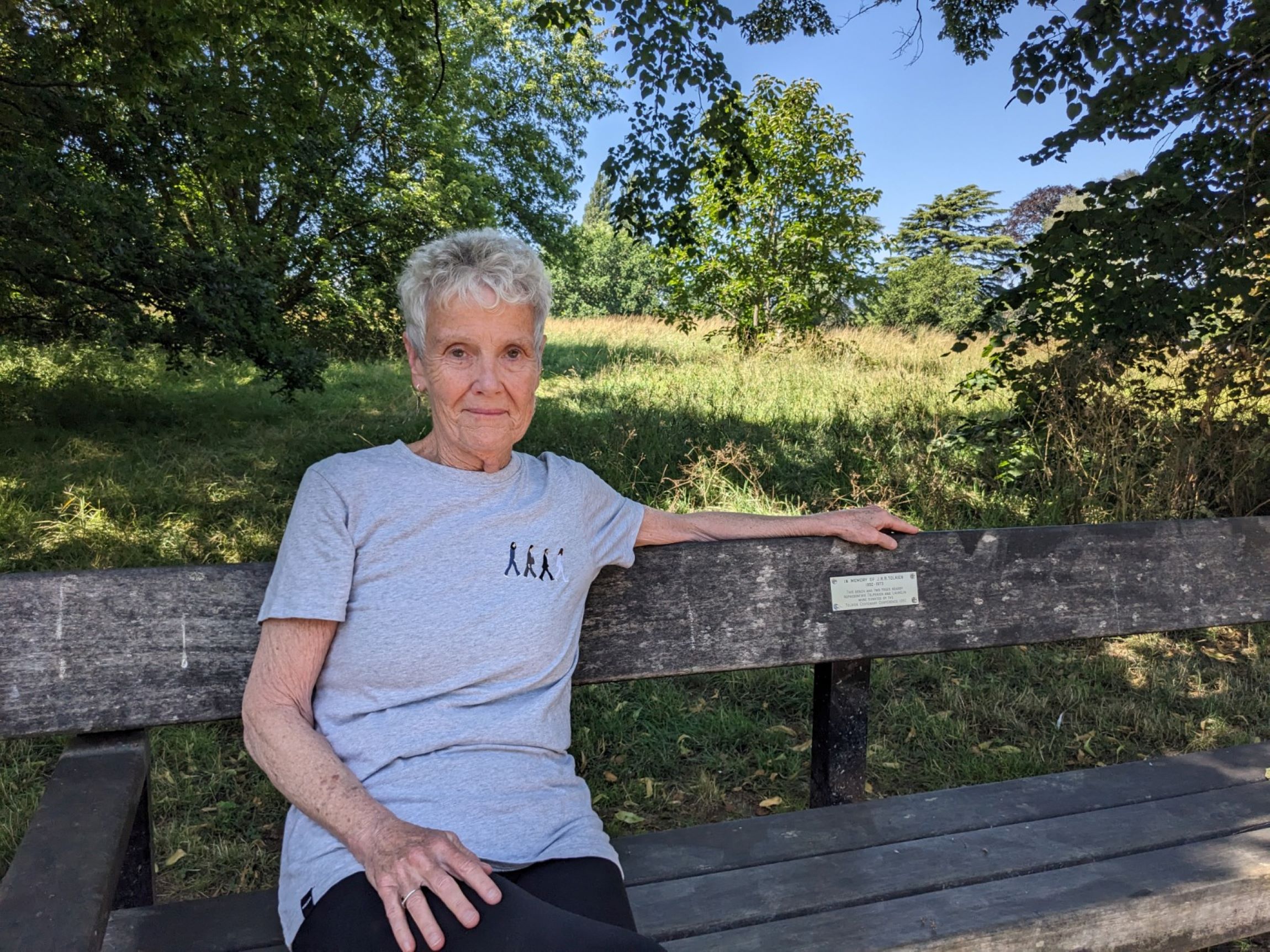
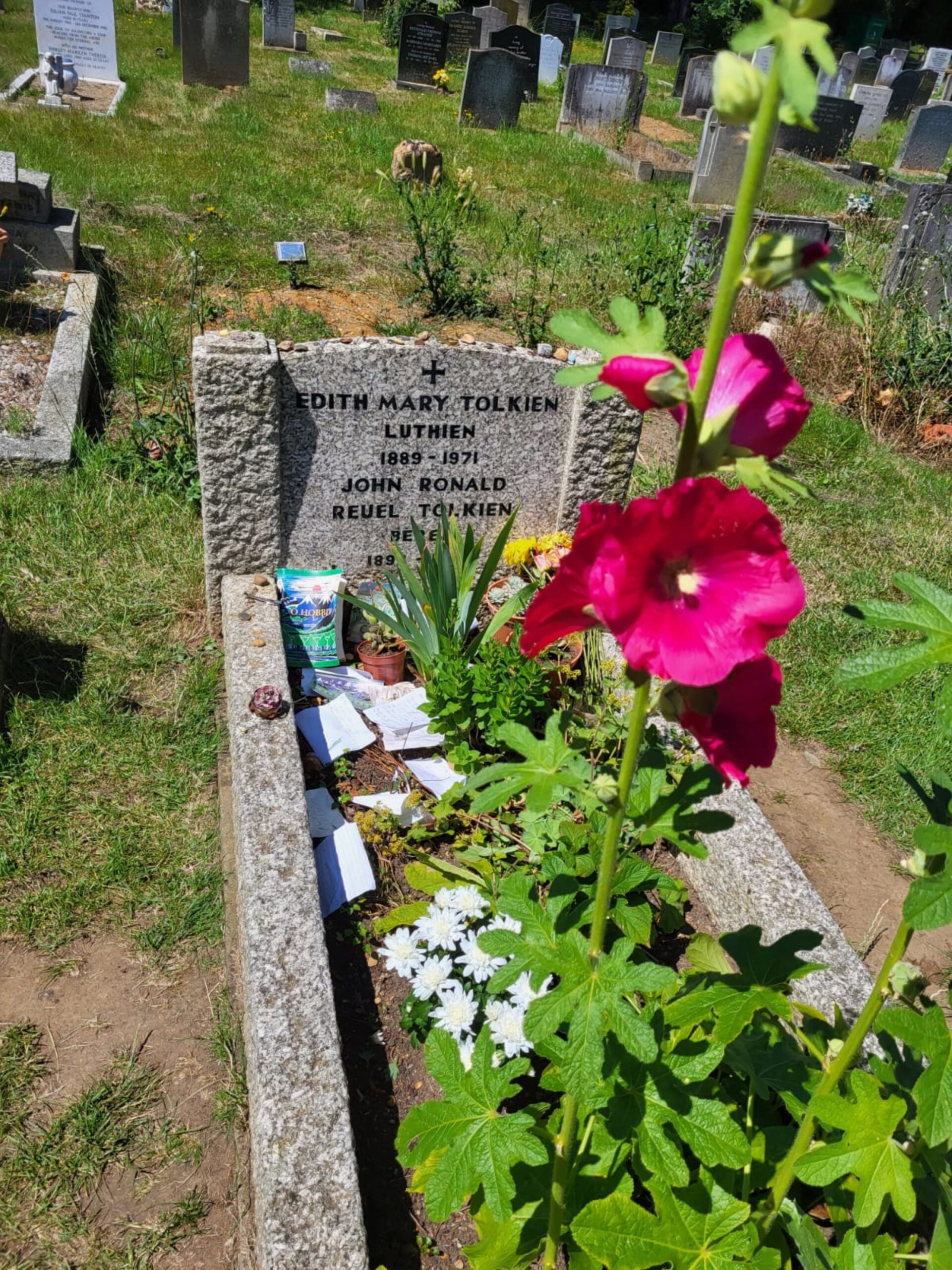
Here I am sitting on a bench where Tolkien often contemplated life. Tolkien’s grave at Wolvercote Cemetery. Wife Edith is named Luthien and Tolkien, Beren, after a heart-wrenching story of his about an Elf woman and a mortal man who were smitten with each other from the moment they met. Note all the letters and even a copy of ‘The Hobbit’ as well as assorted trinkets at the grave. I hope the cemetery staff keeps this memorabilia…
Walking in Oxford is akin to walking straight into a fairytale – an overdone metaphor, perhaps, but no less true for the saying. The University of Oxford with its 39 separate colleges blends into and out of this well-preserved Medieval city, “the city of dreaming spires,” Victorian poet Matthew Arnold wrote. Each of the colleges is unique and self-contained, many fronting the quaint streets of Oxford but behind the gate opening into an entire college campus. Although there is evidence of teaching as far back as 1096, the first colleges were founded between 1249 and 1264. One of these is Merton College where Tolkien taught. My fellow Tolkien companions and I stayed at Wadham College, founded in 1610 so quite a latecomer. (!)
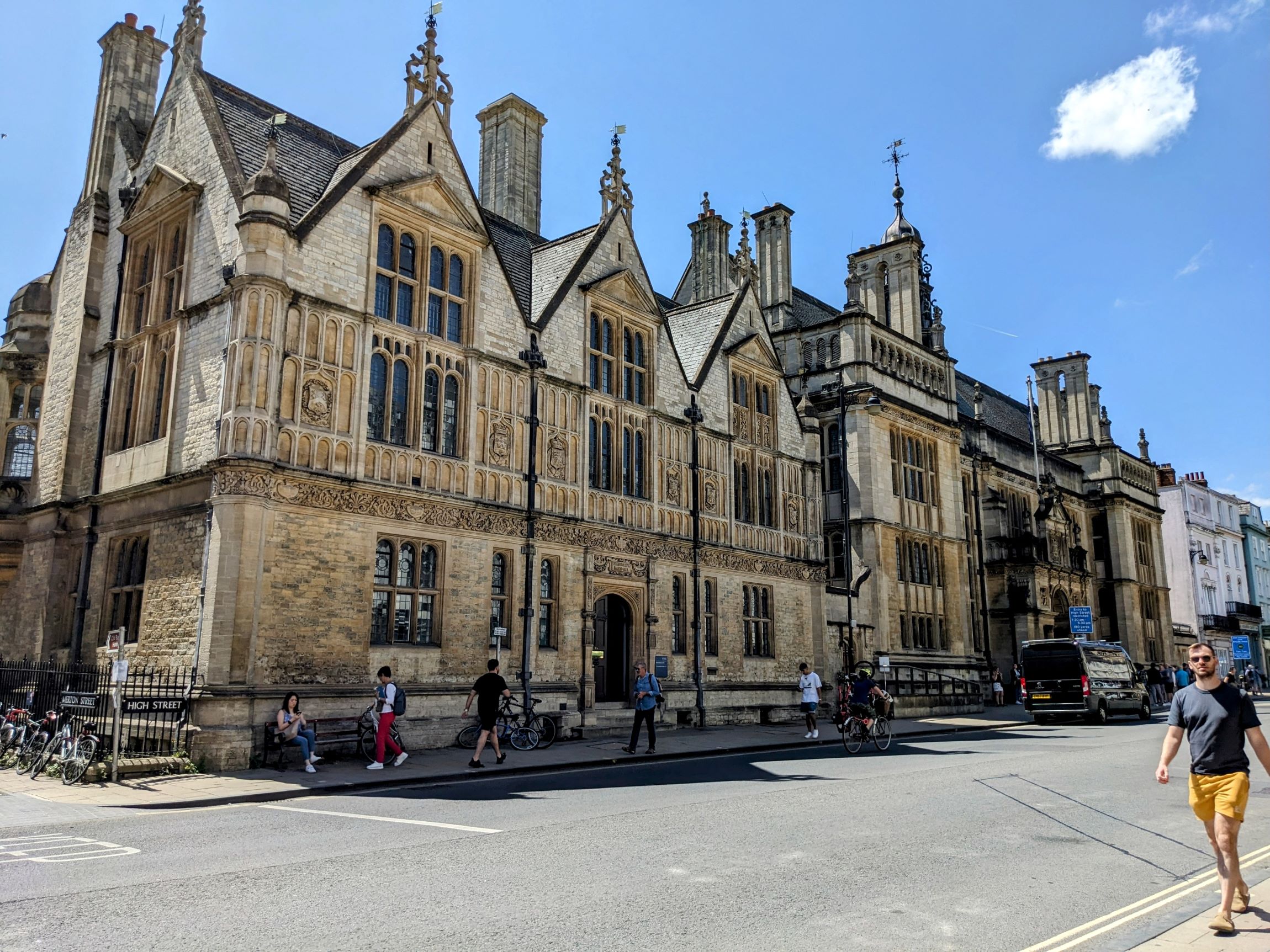
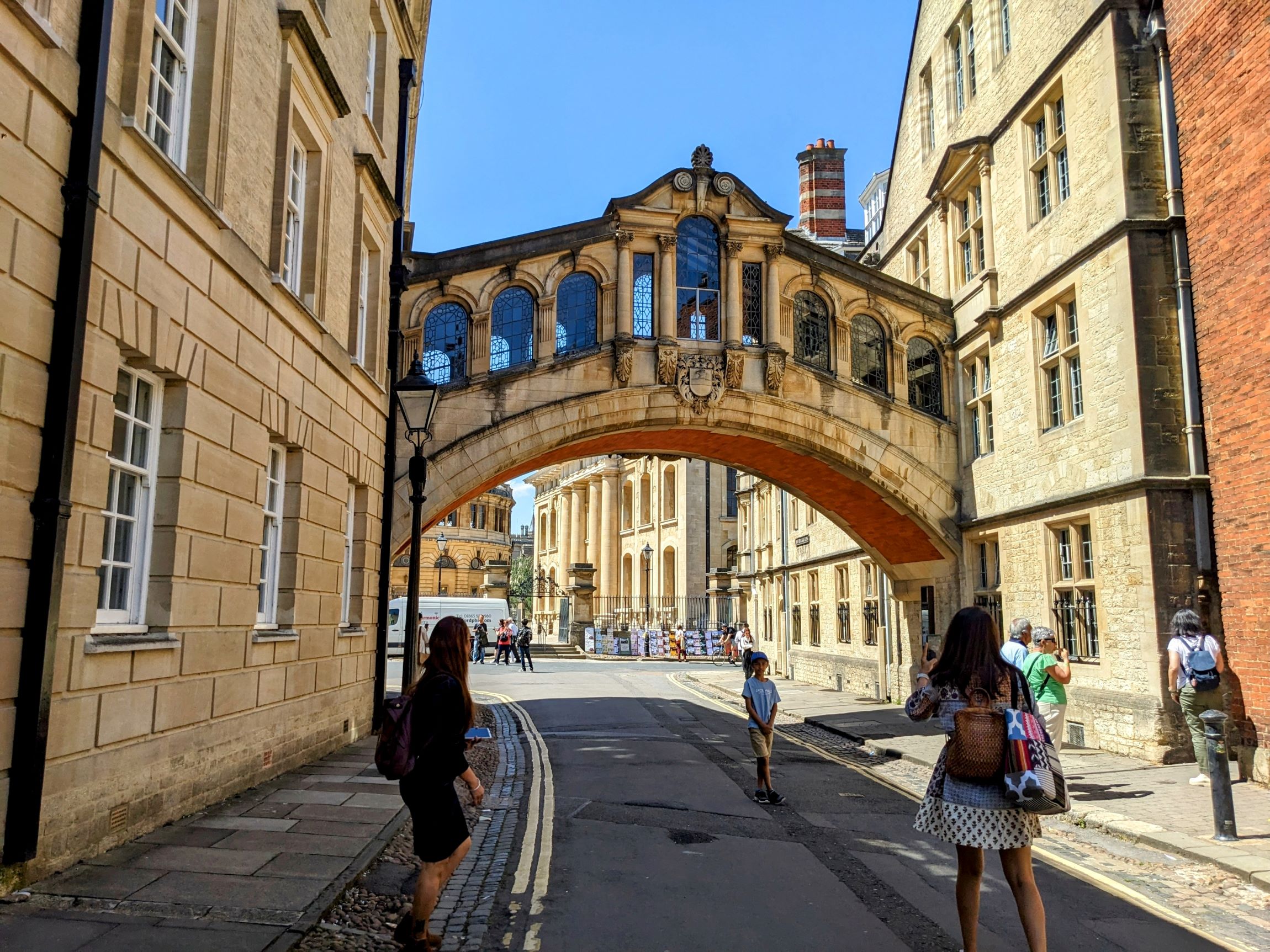
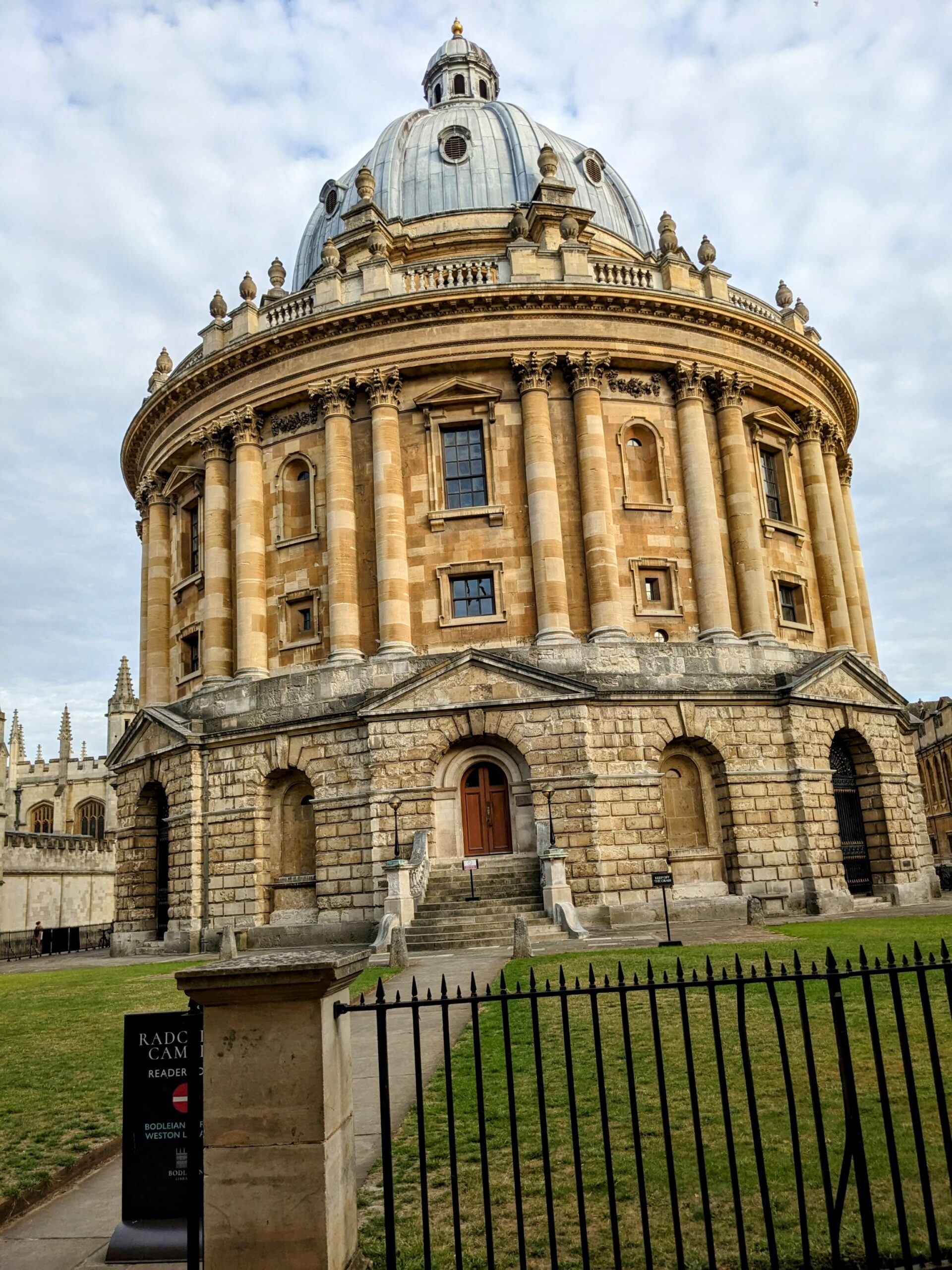
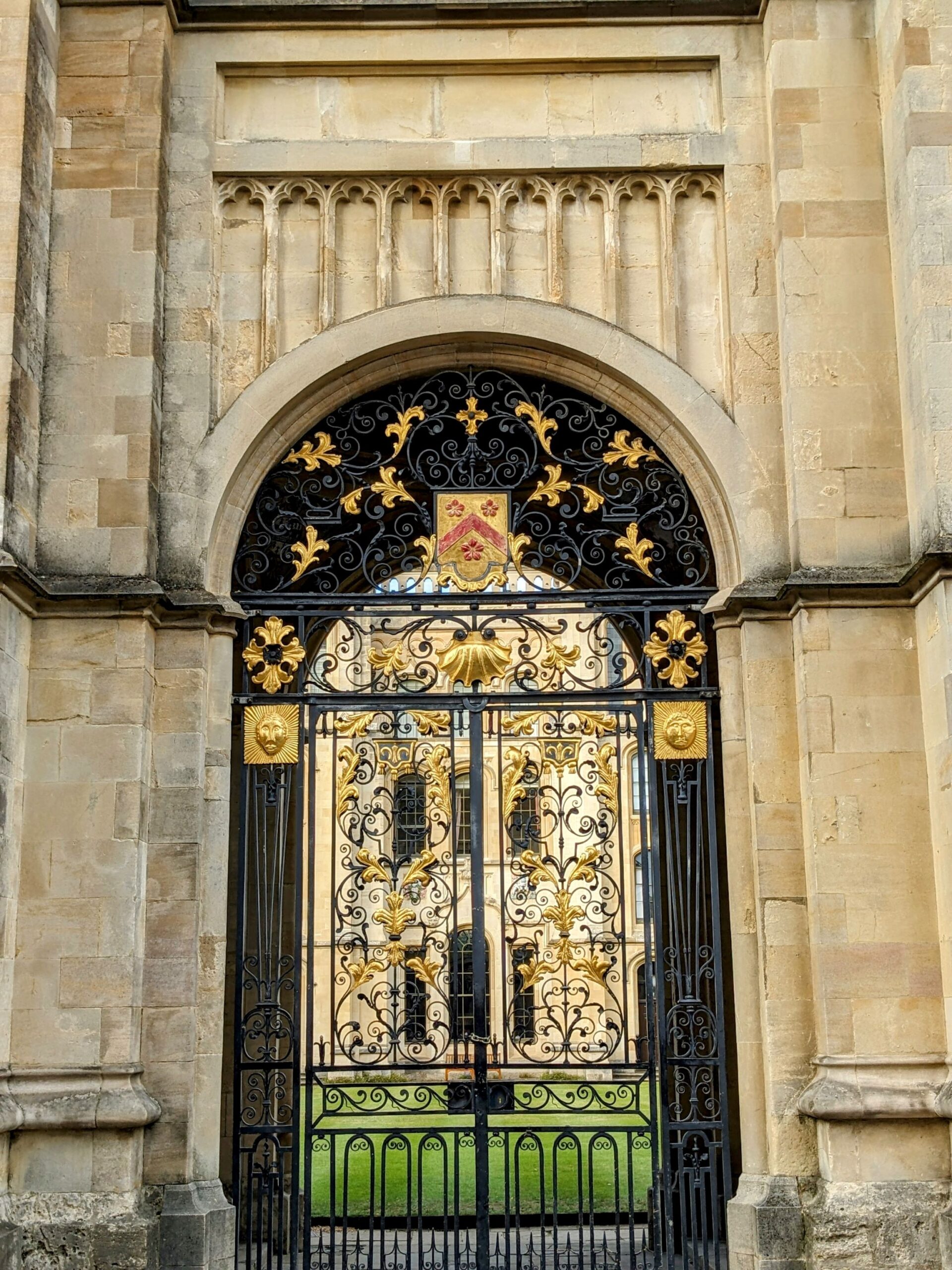
Clockwise from top left: a typical street in Oxford; the Bridge of Sighs, so named for its resemblance to the more famous Bridge of Sighs in Venice, Italy; the Radcliffe Camera, built 1730-49 to house the Radcliffe Science Library; and below, the wonderful wrought iron and gold leaf gate of All Souls College.
Parenthetically, we were given a tour of the archives in the Wadham College library, where reside a first edition King James Bible; four first edition Shakespeare folios, including 36 plays in the first folio, half of which had never been printed before; a first-edition copy of the works of Geoffrey Chaucer, published in 1598; and a 16th century Qur’an, among some prized Dickens and Thackery and others. And remember, Wadham is one of 39 colleges, each with a library and an archives. Boggles the mind.
Speaking of fantasy, and just as a brief aside, it will probably come as no surprise to anyone that a number of scenes from the Harry Potter movies were shot in the city and at the university – including at the Bodleian Library and several places in Christ Church College, including the cathedral. Tours abound, as you can imagine. I wasn’t there long enough, but next time…
I won’t bog this down with a lot of workshop nitty gritty, realizing that not all may share my love of Tolkien and fantasy writing (though why, I can’t possible imagine). 😉 But I will share with you a couple of the places where we travelled that week. Perhaps my favorite was White Horse Hill in Uffington, about 45 minutes from Oxford. Its name derives from the figure of a white horse outlined in chalk (and regularly replenished) that most clearly can be seen from the air. Tolkien and his family often hiked this windswept hill and its environs, which was the likely inspiration for Rohan. Walking here, I could almost hear Theoden lead his riders across the grassy fields. But it’s evocative enough on its own. A beautiful, haunting place.
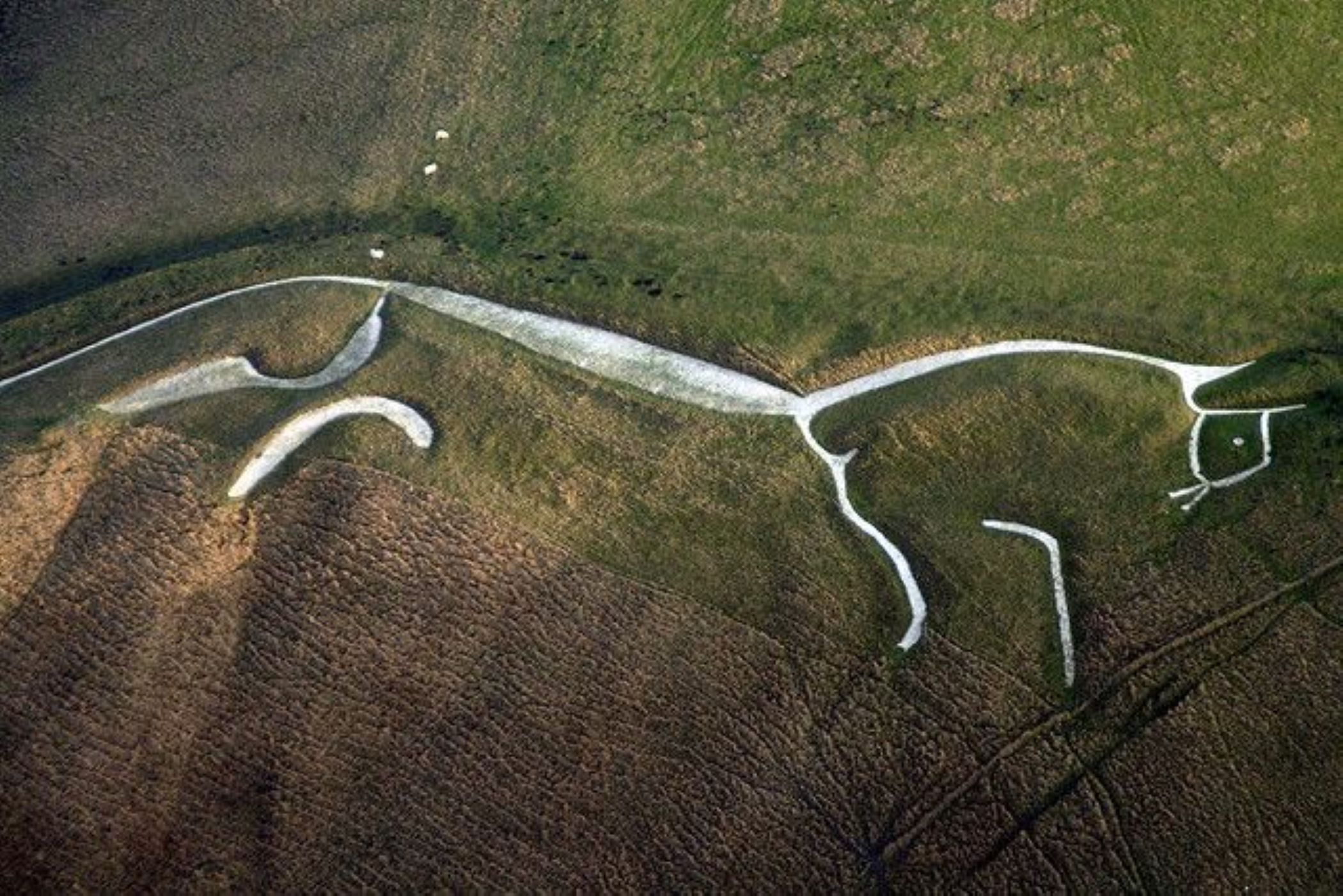
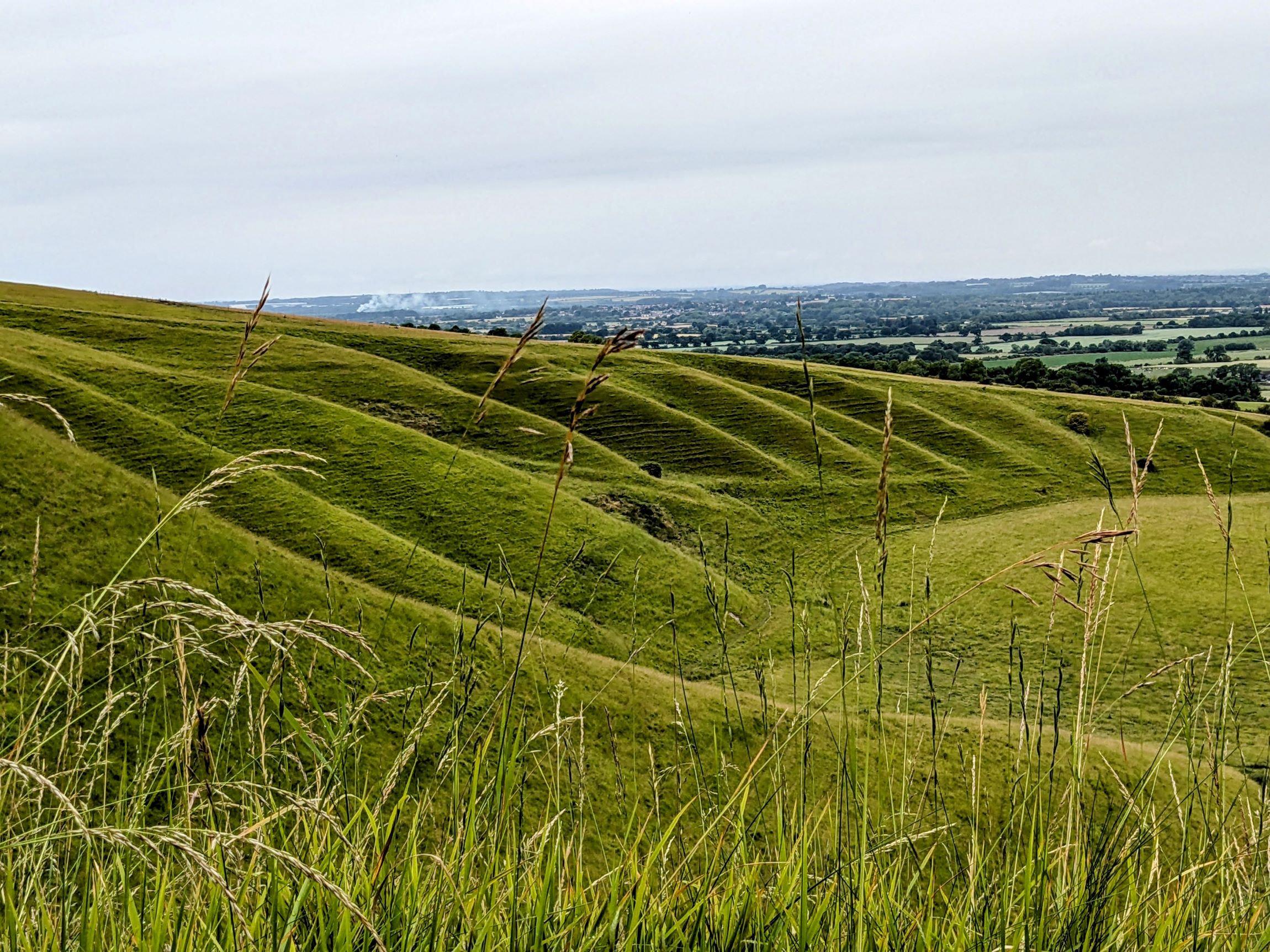
I found this image of White Horse Hill from above so you can see what it looks like. These undulating ripples are known as the Giant’s steps. How evocative!
Just for why not, we also visited Warwick Castle in Warwickshire, originally built by William the Conqueror in 1068(!) and today a sprawling, impeccably-maintained castle-cum-tourist attraction. It has walking troubadours, jugglers, jesters, a jousting arena, strolling lords and ladies, battlements, rooms aplenty to wander through, even, if you are lucky, Queen Elizabeth I and Sir Walter Raleigh. There is something happening everywhere on the grounds, plenty to see and do. Kids would be just agog; I know I would have been. Frankly, it was a bit overload for me, but I definitely see the allure. THE FINE PRINT: Tickets are £26-£29 per person, regardless of age. Parking is £10 close in, £6 further out.
Most of the other places we visited were specifically geared to Tolkien and Lewis – including Lewis’s home The Kilns — so if you’re interested in learning more, let me know and I’ll be happy to fill you in.
THE FINE PRINT: You can rent a room at one of the university colleges, especially during the summer, which may be of interest to some. The university recommends universityrooms.com, and just plug in Oxford and the dates you wish to go. You can take the train, a bus or a private coach from Heathrow Airport in London. If you do drive, like I did, visit JustPark.com. Parking is fairly pricey if you want to be close to the city center. I parked at a hotel about a 20-minute walk away and it was only £36 for 6 nights.
Please go to Oxford. You won’t regret it.
Bookstores addendum
So, for all you readers out there, I would be remiss if I didn’t tell you about two amazing bookstore experiences.
Bookstore experience #1: Blackwell’s in Oxford has served the University and the community for 144 years. It is a city institution, as not only an academic and general interest bookseller but occasional publisher. For instance, in 1915 it published Tolkien’s first poem, Goblin’s Feet, when he was 23. (Tolkien nerd fact: Basil Blackwell, son of the founder, was known as ‘the gaffer.’ For any Sam Gamgee fans out there.)
This is a bookstore the likes of which you’ve never seen before. Think of the largest bookstore you’ve ever been in, and then double it, perhaps triple it. Floor after floor of books, including the vast basement Norrington Room, which truly has to be seen to be believed. Just this room alone would rival many town libraries and exceed most. AND there is a wholly separate shop across the street that specializes in just fantasy literature.

I mean, is this a bookstore section or a library? I present to you the Norrington Room at Blackwell’s. And please remember, this is just a part of the bookstore itself.
Bookstore experience #2: After I left Oxford, I visited friends in Hereford on the Wales border and then wended my way to Fishguard to catch the ferry. My friends, learning of my literary bent, pointed me in the direction of Hay-on-Wye in Wales, which I would pass on the way. If your travels take you to Wales (and my introduction was far too brief), you really must find a way to stop here, reader friends. Called “The Town of Books,” it boasts 25 – that’s 25 – bookstores. I was positively giddy.
These are not your chain booksellers. These are shops jammed floor to ceiling with mostly second-hand books on every topic imaginable. Stacks of books line the narrow aisles between shelves. You walk to what you think is the back, and another whole room opens in front of you. You think you’ve seen everything and then you find a worn staircase leading up or down to another floor. One or two of of the bookshops maybe even rivalled the Norrington Room. Maybe. I arrived in town at 10am and the next thing I knew, it was 3pm. I hadn’t even thought about food, but when I finally realized I was a little hungry, I found a wealth of small cafés and restaurants scattered everywhere. This is a little gem of a town that I would never have known about but for a tip from a friend.
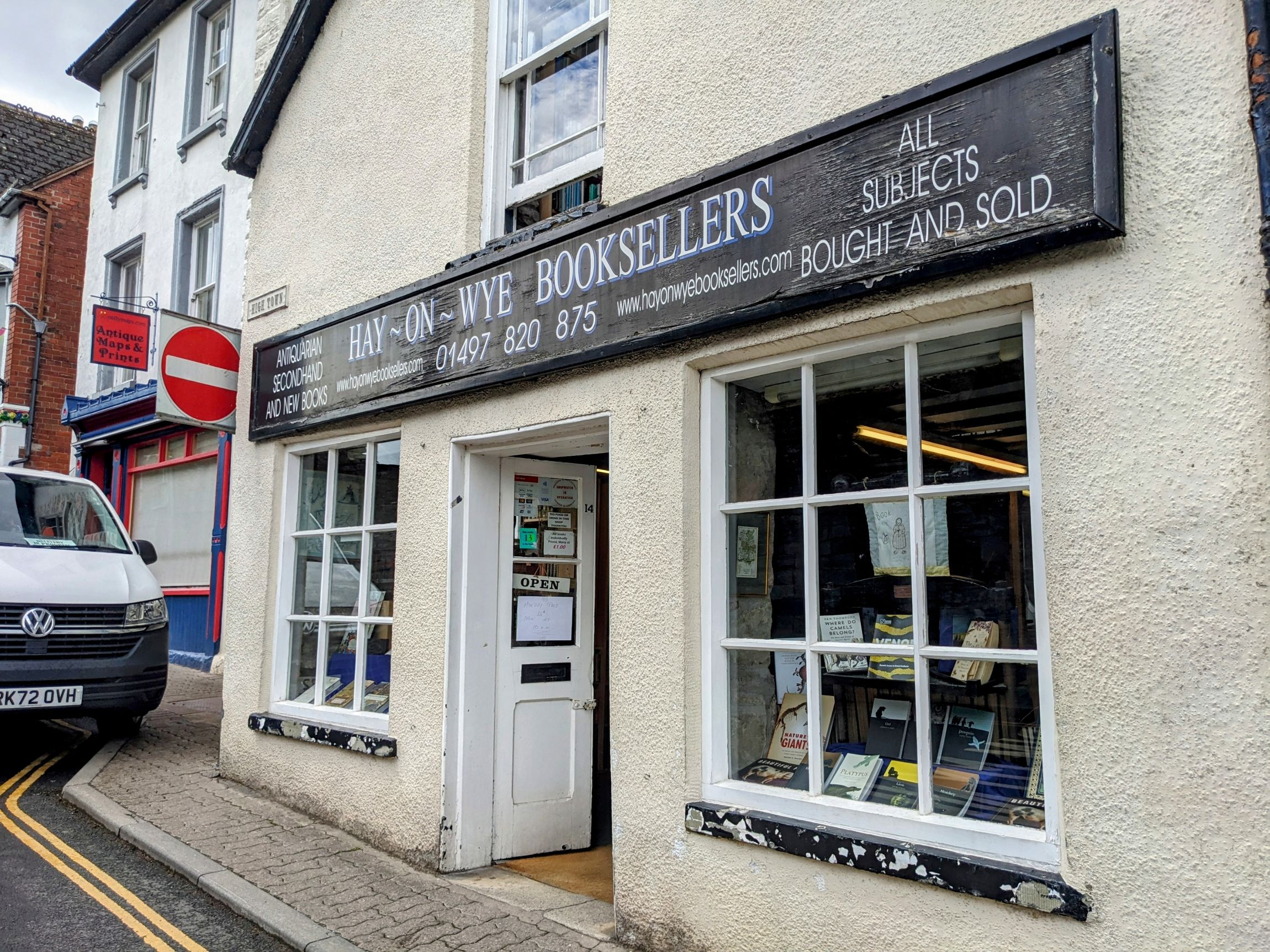

This is just one bookseller with a view of just one of the aisles inside, at “The Town of Books,” Hay-on-Wye in Wales.
Whew!
OK folks, I am as burned out writing this blog as you probably are reading it! I hope you are intrigued enough to visit some of these places if your travels ever take you to Great Britain. Next trip: Edinburgh in two weeks for the Fringe Festival and Copenhagen in October. Life is good.
***
BONUS PS: As part of the workshop in Oxford, we were asked to write quite a bit, usually based on prompts or guidelines provided to us. Many of my companions had full-fledged novels in the making; I did not, although I had/have an idea of something based on Irish mythology. Here is a bit I wrote. And before you ask, I have no idea where it goes from here!
She calls herself Arsa, the ancient one. She has been in the world since the first blade of grass sprouted in the meadow, before birdsong or cricket chirp. She has many homes, tending as she does to roam the land, making sure all is well with the flora and fauna in her domain.
Always, she travels with a wise red fox she has named Finn – once an injured whelp she nursed back to health, now a trusted advisor.
This day, she awakens at her home on the summit of a small hillock. She often chooses to come to this particular place. Although it blends into its surroundings, barely perceptible in the rock and tussock landscape, from its peak she can see afar in all directions.
As the sun rises, Finn trots to her side and sits on his haunches. He is disquieted.
“Something is amiss,” he said, sniffing the air.
“You often say that if even the leaf of a hawthorn looks withered when it oughtn’t,” she gently chides.
“I know, I know,” he said with a sidelong glance at her. “But this is different. Can’t you feel it?”
Because Finn is a bit dramatic, she has too many times dismissed his intuitive ways – to her peril. And so she takes care as she scans the countryside.
There it is. There. A disturbance in the force, a charged atmosphere.
She and Finn see it at the same moment. The fox’s ear lay back. She shivers.
“Oh no,” she whispers.
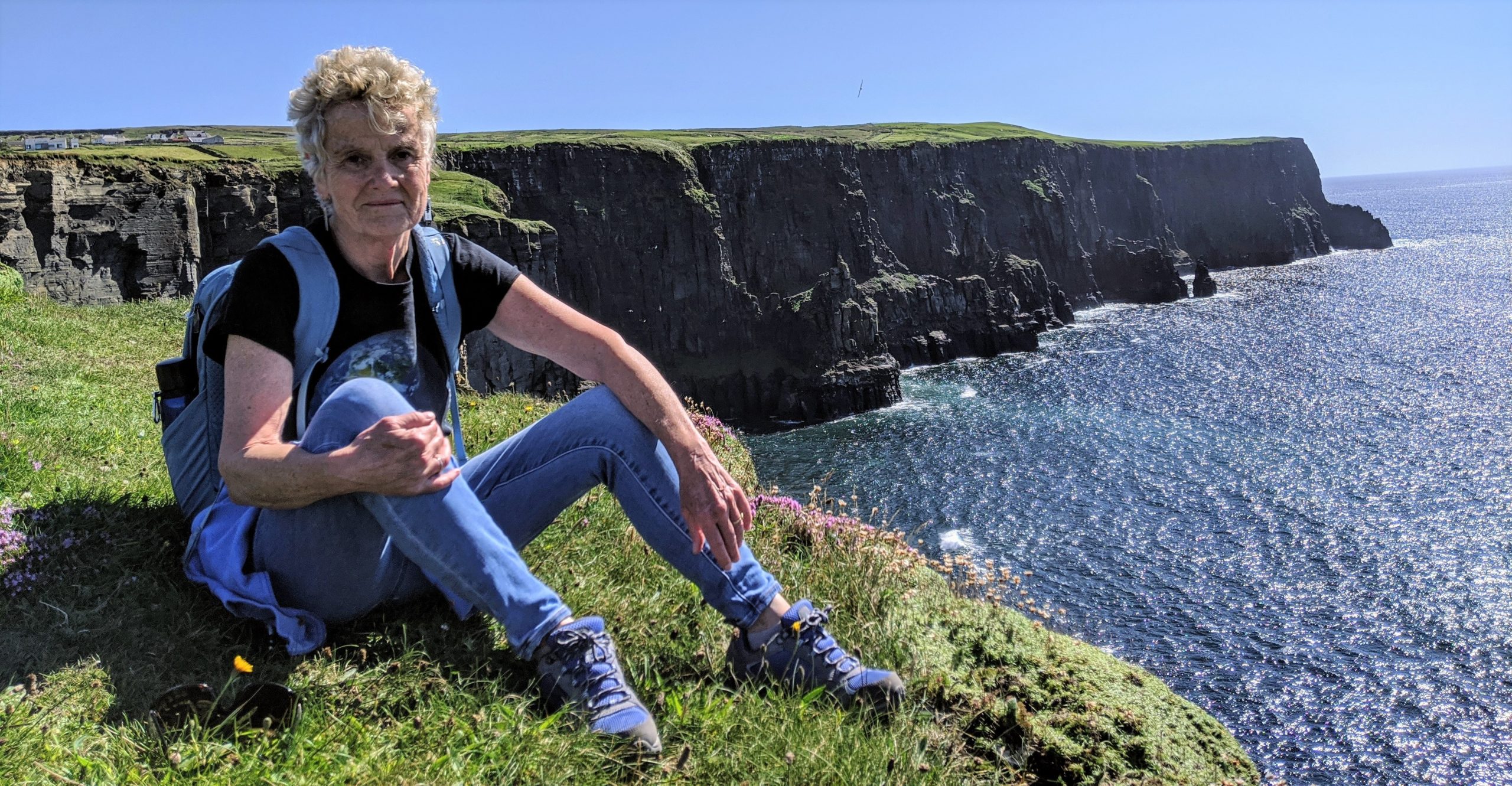
Reader Comments
More, please. I want to make that journey, though, wouldn’t want to do so without you as guide and inspiration. Don’t leave me hanging – what is amiss in the hillside? What do Arsa and Finn feel?
Oh What fun!! Did you get to Edinburgh this year for their music festival that they have in August along with the tatoo? Or is that scheduled for next year?
Whew! So completely interesting. You make it come alive, almost like being there with you. I was, however, fortunate enough to see Stonehenge up close and personal before all the limitations in place now. And, yes, you have peaked my (our?) curiosity enough to continue your story!
Wonderful reading about your adventures in England and Wales. So glad you enjoyed and reveled in the world of Tolkien. Thank you for sharing.
Marti
Such a treat to travel with you : ) Thanjd for sharing!
What a fantastic travelogue… either I must go, or I just lived it vicariously… Wow. Thank you, thank you. Your writing is of course a great source of information and entertainment. And just for the record, I deeply honor the hobbit lovers among us, I am not part of this earthy group. I still want to go and feel the earth shake in Glastonbury! So many paths…